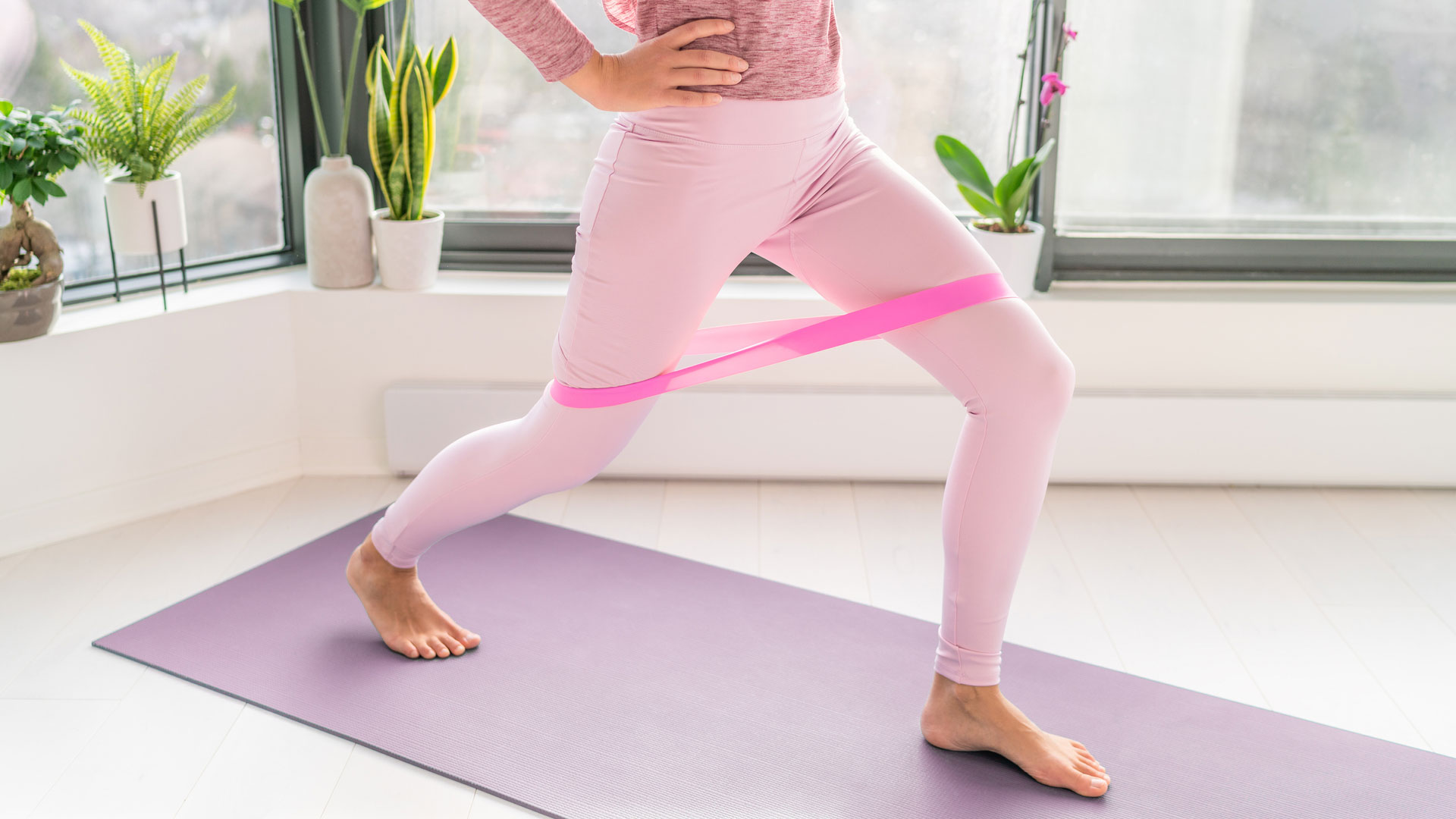What is PNF stretching?
What is PNF stretching? Experts explain the benefits and how to do it safely.

Ever wondered — what is PNF stretching? This technique is also known as proprioceptive neuromuscular facilitation and is commonly used in exercise and injury prevention. Chances are, whether you’ve heard of it or not, you’ve probably seen it before.
But first, what does stretching do to your body? In simplest terms, stretching relaxes, strengthens, and elongates muscles to improve range of motion and reduce the likelihood of injury. Dynamic (moving) stretches are traditionally used pre-workout to prepare muscles and joints for exercise, whereas static (non-moving) ones are beneficial post-workout to aid recovery — though they can be incorporated into warm-ups, too.
There are plenty of ways to stretch, but PNF stretching is said to be a more advanced method favored by athletes to achieve a deeper stretch. However you decide to exercise, PNF stretching could improve your performance and aid recovery.
We spoke to experts to find out more. Discover the many benefits of stretching for your body and the best yoga mats to perform them on, or read on to learn more about PNF stretching.
What are PNF stretches?

Rami Hashish obtained his PhD in biomechanics from the university of Southern California in 2014. He then worked as a clinical instructor of physical therapy for several years before founding the national biomechanics institute.
According to Rami Hashish (PhD, DPT) body performance and injury expert, the contract-relax method is arguably the most common PNF stretching technique and facilitates a deeper stretch to improve range of motion.
“With this method of stretching, a passive stretch is applied to a muscle or muscle group, then active contraction is performed by the muscle being stretched,” explains Hashish. “This results in a bit of short-term fatigue to the muscle. The muscle is then relaxed and assisted into a deeper stretch.”
Hashish explains that consistent PNF stretching can increase range of motion and overall flexibility, leading to improvement in muscle and sports performance. And the research, like this study published in the Journal of Human Kinetics, agrees.
Get the world’s most fascinating discoveries delivered straight to your inbox.
Hope Choplin, certified clinical exercise physiologist and coach at Noom, adds that PNF was originally developed in the late 1940s for people with neurological conditions before also being adopted for musculoskeletal conditions. “Now it’s commonly used by therapists, athletes, and dancers,” she says. “In recent years, it is also popular in gyms because of its association with ‘quick results.’”

“As an ACSM Certified Clinical Exercise Physiologist, "exercise is medicine" resonates with me, and I have spent time working with both sides of the wellness spectrum. I spent 10+ years creating and implementing clinical group exercise programming for people with cardiac and peripheral artery disease, using cognitive behavior therapy and motivation interviewing to construct meaningful health and wellness goals. Additionally, I have personal training expertise with post-stroke and TBI (traumatic brain injury) individuals. While I think post-event therapy is important, providing intervention before a major medical event is a shift in the wellness continuum that is long overdue. As a health coach, I love impacting this crucial juncture for many.”

What are the three types of PNF stretches
According to the International Journal of Sports Physical Therapy, PNF stretching falls into three categories. But before we delve into them, let’s quickly cover the most common stretching methods:
- Static stretching: Involves holding a muscle under tension without movement, with or without using a prop or partner. Passive stretching requires a prop to add resistance, like a wall or resistance band.
- Dynamic stretching: This sport-specific warm-up stretch includes active and ballistic stretching. Active involves moving a limb through its full range of motion, like leg swings. Ballistic stretching involves a rapid ‘bouncing’ movement (like a bouncing toe-touch) at the end range of motion, but it isn’t recommended as a stretching technique anymore.
PNF sits under pre-contraction stretching and is a passive form of stretch that requires contraction and relaxation of muscles to their limit against a prop or partner, performed repetitively.
PNF is thought to trigger an inverse myotatic reflex. Essentially, this tells your muscles to relax before they get injured. Think of it as a protective chat between your brain and muscles. Strangely though, research — like this study mentioned above — says it’s still a working theory.
Regardless, PNF is divided into three types: contract-relax, hold-relax, and contract-relax agonist contract (CRAC) — which we break down below.
Other benefits of PNF stretching
We’ve already covered benefits like an increased range of motion and flexibility, but PNF can also help strengthen muscle groups and improve performance.
“Increased strength isn’t commonly considered with stretching,” Choplin says. “However, studies have shown that performing a PNF stretching routine before exercising for a couple of months (two times a week for eight weeks) can double the effectiveness in joggers and movements such as a vertical jump and throwing distance.”
Chartered physiotherapist, Ben Lombard, specializes in treating sports injuries and agrees it’s a useful technique.
“It works on the principle of gently holding a sustained contraction of a muscle that is being gently stretched,” he explains. “This action stimulates special receptors in your joints, called Golgi tendons, which helps the muscle to relax.”
But Lombard advises using it as part of a cluster of treatments rather than standalone, and also in conjunction with dynamic stretching and strengthening of target muscles for best results; this is because the technique isn’t very dynamic when performed by itself.

Ben Lombard is a private Chartered Physiotherapist working in London. He specializes in sports injuries but over the last few years has broadened his scope to become a specialist consultant in postural rehabilitation and the treatment of scoliosis.

How do you perform PNF?
It’s worth reiterating that to fully benefit from PNF stretching it needs to be performed carefully with a person or prop, like the best resistance bands or a friend. Hashish agrees that implementing it into a regular stretching and exercise routine could maximize your results.
Hold-relax
“The hold-relax technique involves stretching the target muscle, then holding it for a few seconds,” explains Hashish. “The muscle then performs an isometric contraction where the muscle contracts without moving. After relaxing the contraction, the passive stretch can be repeated, deeper.”
For example, if a trainer is helping you stretch your hamstrings while you lie on your back, they would passively stretch you into a straight leg raise until you feel resistance. After holding the passive stretch, you would contract your hamstrings by pressing against the trainer’s resistance; the trainer would apply sufficient resistance to prevent any active movement of your leg. After this contraction, you can relax, and the trainer deepens the passive hamstring stretch.
Contract-relax
“The contract-relax method is nearly identical to hold-relax, but the muscle contracts while moving,” adds Hashish. “For example, as you contract your hamstrings, the back of your knee would move closer to the ground as you push against the trainer’s resistance. You then relax as the trainer stretches you into a deepened position.”

Contract-relax-contract
Contract-relax-contract is similar to contract-relax, but after relaxing the contraction, the opposing muscle group contracts while the trainer assists in deepening the stretch.
In other words, after pushing against the trainer’s resistance so that the back of your knee gets closer to the ground, you now reverse the action by bringing your still straightened knee closer to your chest while the trainer assists in deepening the stretch.
Not sure how to stretch your hamstrings? Make sure you learn some basic stretching techniques first, including how to stretch your lower back, too.
What are the drawbacks of PNF stretching?
Hashish warns that performing PNF stretching before exercise may result in reduced performance. According to a study in the Journal of Human Kinetics, this can decrease muscular performance in plyometrics, sprinting, weightlifting, and high-intensity training where maximal muscle effort is required, possibly due to an ‘inhibiting effect’ after stretching.
However, performing it after (or without) exercise was shown to significantly increase performance when performed at least twice a week, with effects lasting around 90 minutes post-stretch.
Use this method with caution, especially if you’re a beginner to exercising or PNF as a technique. Choplin tells us that PNF stretching hasn’t consistently been shown to be superior to ‘regular’ stretching and requires a partner who knows how to perform it — something that can otherwise cause muscle tears and injury to novice stretchers.
She advises a few simple ways to reduce your risks:
- Don’t begin a PNF stretching routine without being shown the proper procedure by a professional trainer
- Children and teens should not attempt PNF stretching as their bones haven’t finished growing, and they’re often more flexible than adults, which could result in a higher risk of connective tissue or tendon damage.
- More advanced PNF stretching methods should only be used by professional dancers or athletes.
“While PNF stretching has a place, especially for advanced exercisers, athletes and dancers, or in the realm of therapy, it may not be a practical form of stretching for everyone,” Choplin adds.
“PNF stretching can be extremely difficult without a skilled partner. Individuals can rest assured that leaning into more traditional forms of stretching — active, passive, or dynamic — will still benefit from improved flexibility and range of motion.”
It’s also recommended to avoid unstable joints, like your shoulders, and use the stretch for your back and lower body.

Sam Hopes is a level III fitness trainer, level II reiki practitioner, and resident fitness writer at Future PLC. Having trained to work with both the mind and body, Sam is a big advocate of using mindfulness techniques in sport and aims to bring mental wellbeing to the forefront of fitness. She’s also passionate about the fundamentals of training and how we can build more sustainable training methods. You’ll find her writing about the importance of habit-building, nutrition, sleep, recovery, and workouts.


